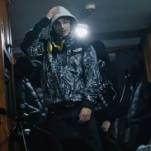Created through a time-consuming, antiquated process called aquatinting, Incestuous Sisters looks very much like an Edward Gorey book with the scratchy fine interior shading replaced by a textured wash of dark, broody color. The simple story follows three sisters who live together near the sea and it's told mostly through expressive and sometimes surreal images, each generally captioned by a single sentence. The results are sometimes wryly amusing and sometimes grim, but while the streamlined art shows the effort of the process which went into it, it doesn't communicate soul-deep pain as effectively as Niffenegger's prose, which is here kept to a calculated, almost haiku-economic minimum. Readers who found Niffenegger through her novel are likely to miss her more overt voice.
Lack of words isn't a problem in Joann Sfar's dense graphic novel The Rabbi's Cat, which packs in so much text that the twisted, variable, brightly colorful art seems like a secondary consideration. Much of the appeal of Sfar books like Dungeon is their sheer unpredictability; Sfar has no compunctions about setting up a terrific premise, then walking off to another one to keep things fresh. The Rabbi's Cat begins in '30s-era Algiers, where a rabbi's cat eats a talking parrot, gains the power of speech, and begins debating religion and ethics with the rabbi and the rabbi's teacher, insightfully but with all a cat's self-serving amorality. It's heady, fascinating stuff, but Sfar casually moves on to an observational mode, delving into the further life of the rabbi's daughter, her husband, and the husband's family, who represent different ages, countries, cultures, and points of view. What begins as a piquant story about a perspective outside humanity becomes a richer narrative about the possibilities humanity has to offer.









































